Diagnosing issues with your 2002 Ford Ranger often starts with connecting an OBD2 scanner to the diagnostic port. However, if your scanner isn’t powering up or connecting, a blown fuse might be the culprit, specifically the one protecting your OBD2 port, also known as the Data Link Connector (DLC). Understanding the 2002 Ford Ranger Obd2 Fuse Location is crucial for quick troubleshooting and getting your diagnostics back on track.
Fuses are essential safety devices in your vehicle’s electrical system. They protect sensitive components from power surges and overloads. When electrical parts in your Ranger stop working, checking the fuses should always be your first step before considering more complex repairs. This guide will pinpoint the 2002 Ford Ranger OBD2 fuse location and provide comprehensive fuse box diagrams to help you identify and replace any blown fuses in your 2002 Ford Ranger.
This article provides detailed information on both the passenger compartment fuse panel and the power distribution box in your 2002 Ford Ranger. We’ll show you exactly where these fuse boxes are located and provide fuse diagrams to help you quickly find the fuse related to your OBD2 port and other essential vehicle systems. If a fuse blows, the circuits it protects will become inactive, causing various electrical malfunctions. Let’s dive into locating and checking those fuses to get your Ford Ranger back in top shape.
Passenger Compartment Fuse Panel Location and Diagram
The passenger compartment fuse panel in your 2002 Ford Ranger is conveniently located inside the vehicle, making it easily accessible. You’ll find it on the left end of the instrument panel, essentially on the driver’s side.
To access this fuse panel, you’ll need to remove the fuse panel cover. Simply insert your finger into the designated divot and gently pull the cover off. Inside the cover, you might find spare fuses, a handy feature for on-the-go replacements. Additionally, a fuse pulling tool is often located in the fuse panel itself, typically in the lower right corner, to assist in safely removing fuses.
Once you have the cover removed, you can use the diagram below to locate specific fuses within the passenger compartment fuse panel. This diagram is crucial for identifying the 2002 Ford Ranger OBD2 fuse location, which is linked to the Data Link Connector (DLC).
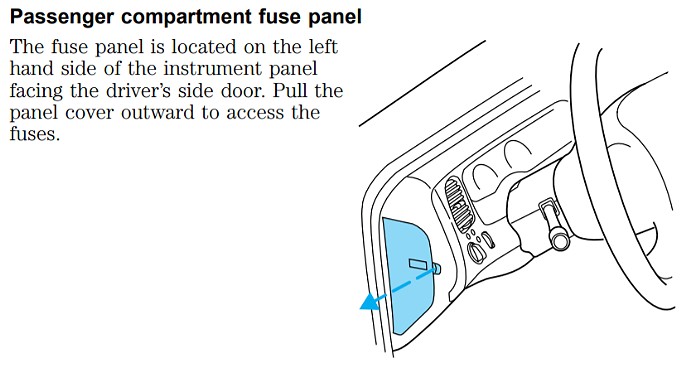 Passenger Compartment Fuse Panel Location in a Ford Ranger
Passenger Compartment Fuse Panel Location in a Ford Ranger
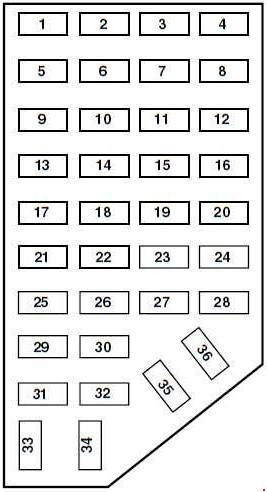 1998-2000 Ford Ranger Passenger Compartment Fuse Box Diagram
1998-2000 Ford Ranger Passenger Compartment Fuse Box Diagram
| No. | AMPS | Protected circuits |
|---|---|---|
| 1 | 5 | Power Mirror Switch |
| 2 | 10 | Daytime Running Lights (DRL), Back-up Lamps, Transmission, Passenger Air Bag Deactivation Switch, Blower Motor Relay |
| 3 | 7.5 | 2001-2002: Right Stop/Turn Trailer Tow Connector |
| 4 | — | Not Used |
| 5 | 15 | 4×4 Control Module |
| 6 | 2 | 2002-2003: Brake Pressure Switch |
| 7 | 7.5 | 2001-2002: Left Stop/Turn Trailer Tow Connector |
| 8 | — | Not Used |
| 9 | 7.5 | Brake Pedal Position Switch |
| 10 | 7.5 | Speed Control Servo/Amplifier Assembly, Generic Electronic Module (GEM), Shift Lock Actuator, Turn Signals, 4×4 |
| 11 | 7.5 | Instrument Cluster, 4×4, Main Light Switch, Truck Central Security Module (TCSM), GEM |
| 12 | — | Not Used |
| 13 | 20 | Brake Pedal Position Switch |
| 14 | 10 | ABS Control Module |
| 15 | — | Not Used |
| 16 | 30 | Windshield Wiper Motor, Wiper Hi-Lo Relay, Wiper Run/Park Relay |
| 17 | 20 | Cigar Lighter, Data Link Connector (DLC) (OBD2 Port) |
| 18 | — | Not Used |
| 19 | 25 | Powertrain Control Module (PCM) Power Diode, Ignition, PATS |
| 20 | 7.5 | Generic Electronic Module (GEM), Radio |
| 21 | 15 | Flasher (Hazard) |
| 22 | 20 | Auxiliary Power Socket |
| 23 | — | Not Used |
| 24 | 7.5 | Clutch Pedal Position (CPP) switch, Starter Interrupt Relay |
| 25 | — | Not Used |
| 26 | 10 | Battery Saver Relay, Auxiliary Relay Box, Restraint Central Module (RCM), Generic Electroic Module (GEM), Instrument Cluster |
| 27 | — | Not Used |
| 28 | 7.5 | Generic Electronic Module (GEM), Radio |
| 29 | 20 | Radio |
| 30 | — | Not Used |
| 31 | — | Not Used |
| 32 | — | Not Used |
| 33 | 15 | Headlamps, Daytime Running Lamps (DRL) Module, Instrument Cluster |
| 34 | — | Not Used |
| 35 | 15 | Horn Relay if Not Equipped with Truck Central Security Module |
| 36 | — | Not Used |
Locating the OBD2 Fuse: As highlighted in the table above, fuse number 17 in the passenger compartment fuse panel (20 Amp) protects the Data Link Connector (DLC), which is your OBD2 port. If you’re experiencing issues with your OBD2 scanner not powering on when connected to your 2002 Ford Ranger, this is the primary fuse to inspect.
Power Distribution Box Location and Diagram
In addition to the passenger compartment fuse panel, your 2002 Ford Ranger also has a power distribution box. This box houses fuses and relays that manage higher-current circuits and is located in the engine compartment.
Specifically, the power distribution box is situated on the driver’s side of the engine compartment, near the fender. This location keeps it protected from the elements while still being accessible for maintenance.
The following diagrams illustrate the power distribution box and its fuse layout for various 2002 Ford Ranger engine configurations. It’s important to use the diagram that corresponds to your engine type (2.3L, 3.0L, or 4.0L) for accurate fuse identification.
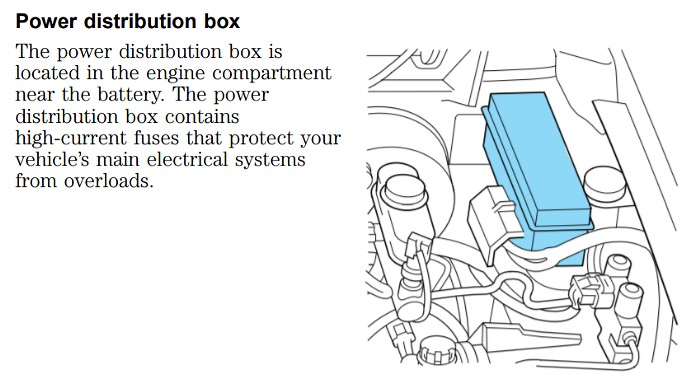 Power Distribution Box Location in Engine Compartment
Power Distribution Box Location in Engine Compartment
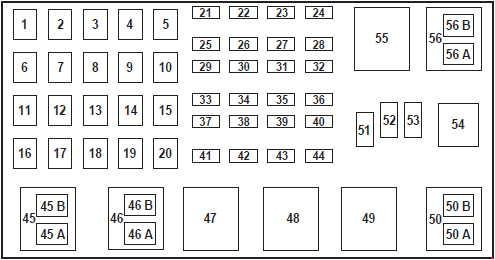 2001 Ford Ranger 2.3L Engine Power Distribution Box Diagram
2001 Ford Ranger 2.3L Engine Power Distribution Box Diagram
2.3L Engine (above)
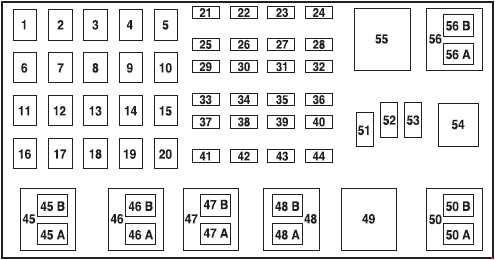 2001 Ford Ranger 3.0L & 4.0L Engines Power Distribution Box Diagram
2001 Ford Ranger 3.0L & 4.0L Engines Power Distribution Box Diagram
3.0L & 4.0L Engines (2001)(above)
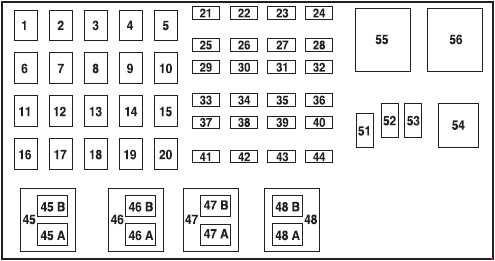 2003 Ford Ranger 3.0L & 4.0L Engines Power Distribution Box Diagram
2003 Ford Ranger 3.0L & 4.0L Engines Power Distribution Box Diagram
3.0L & 4.0L Engines (2002-2003)(above)
| No. | AMP | Protected circuits |
|---|---|---|
| 1 | 50 | I/P Fuse Panel |
| 2 | 50 | Amplifier (Tremor audio system only) |
| 3 | — | Not Used |
| 4 | — | Not Used |
| 5 | — | Not Used |
| 6 | 50 | ABS Pump Motor |
| 7 | 30 | Powertrain Control Module (PCM) |
| 8 | 20 | Power Door Locks and Remote Entry |
| 9 | — | Not Used |
| 10 | — | Not Used |
| 11 | 50 | Starter Relay, Ignition Switch |
| 12 | 20 | Power Windows |
| 13 | 20 | 3.0L and 4.0L engines: 4×4 Motor |
| 14 | — | Not Used |
| 15 | — | Not Used |
| 16 | 40 | Blower Motor |
| 17 | 20 | 2.3L engine: Auxiliary Cooling Fan |
| 18 | — | Not Used |
| 19 | — | Not Used |
| 20 | — | Not Used |
| 21 | 10 | PCM Memory |
| 22 | — | Not Used |
| 23 | 20 | Fuel Pump Motor |
| 24 | 30 | Headlamps |
| 25 | 10 | A/C Clutch Solenoid |
| 26 | — | Not Used |
| 27 | — | Not Used |
| 28 | 30 | 4WABS Module |
| 29 | — | Not Used |
| 30 | 15 | Trailer Tow |
| 31 | 20 | Foglamps, Daytime Running Lamps (DRL) |
| 32 | — | Not Used |
| 33 | 15 | Park Lamp |
| 34 | — | Not Used |
| 35 | — | Not Used |
| 36 | — | Not Used |
| 37 | — | Not Used |
| 38 | 10 | Left Headlamp Low Beam |
| 39 | — | Not Used |
| 40 | — | Not Used |
| 41 | 20 | Heated Oxygen Sensors |
| 42 | 10 | Right Headlamp Low Beam |
| 43 | — | 2.3L engine: (Resistor) |
| 44 | — | Not Used |
| 51 | — | Not Used |
| 52 | — | Not Used |
| 53 | — | Diode: Powertrain Control Module (PCM) |
| Relay | ||
| 45A | Wiper HI/LO | |
| 45B | Wiper Park/Rim | |
| 46A | 2.3L engine: Fuel Pump 3.0L and 4.0L engines (2002-2003): Fuel Pump | |
| 46B | 2.3L engine: Trailer Tow 3.0L and 4.0L engines (2001): Front Washer Pump 3.0L and 4.0L engines (2002-2003): Trailer tow | |
| 47 | 2.3L engine: Starter 3.0L and 4.0L engines (2001): A/B – Not Used | |
| 47A | 3.0L and 4.0L engines (2002-2003): A/C clutch solenoid | |
| 47B | 3.0L and 4.0L engines (2002-2003): Front washer pump | |
| 48 | 2.3L engine: Auxiliary Cooling Fan | |
| 48A | 3.0L and 4.0L engines: Fog Lamps | |
| 48B | 3.0L and 4.0L engines: Fog Lamp Relay | |
| 49 | 3.0L and 4.0L engines (2001): Starter | |
| 50 | Not Used | |
| 50A | 3.0L and 4.0L engines (2001): Not Used | |
| 50B | 3.0L and 4.0L engines (2001): Fuel Pump | |
| 54 | Powertrain Control Module (PCM) | |
| 55 | Blower | |
| 56 | 3.0L and 4.0L engines (2002-2003): Starter | |
| 56A | A/C Clutch Solenoid | |
| 56B | 2.3L engine: Front Washer Pump 3.0L and 4.0L engines (2001): Trailer Tow |
While the power distribution box doesn’t directly house the OBD2 port fuse, it controls numerous critical vehicle functions. Understanding its layout is helpful for diagnosing a wider range of electrical issues in your 2002 Ford Ranger.
Step-by-Step Guide to Checking and Replacing Fuses
Once you’ve located the fuse panel and identified the potential 2002 Ford Ranger OBD2 fuse location or any other fuse you suspect is blown, follow these steps to check and replace it:
-
Access the Fuse Panel: For the passenger compartment fuse panel, ensure you’ve removed the cover as described earlier. For the power distribution box, open the cover located in the engine compartment.
-
Locate the Fuse: Refer to the fuse panel cover or the diagrams provided in this article to find the specific fuse number you want to inspect. The fuse panel cover usually has a diagram printed on its underside, indicating the position of each fuse.
-
Inspect the Fuse: Visually check the fuse to see if it’s blown. Look at the thin metal wire inside the clear plastic body of the fuse. If the wire is broken or melted, the fuse is blown and needs replacement.
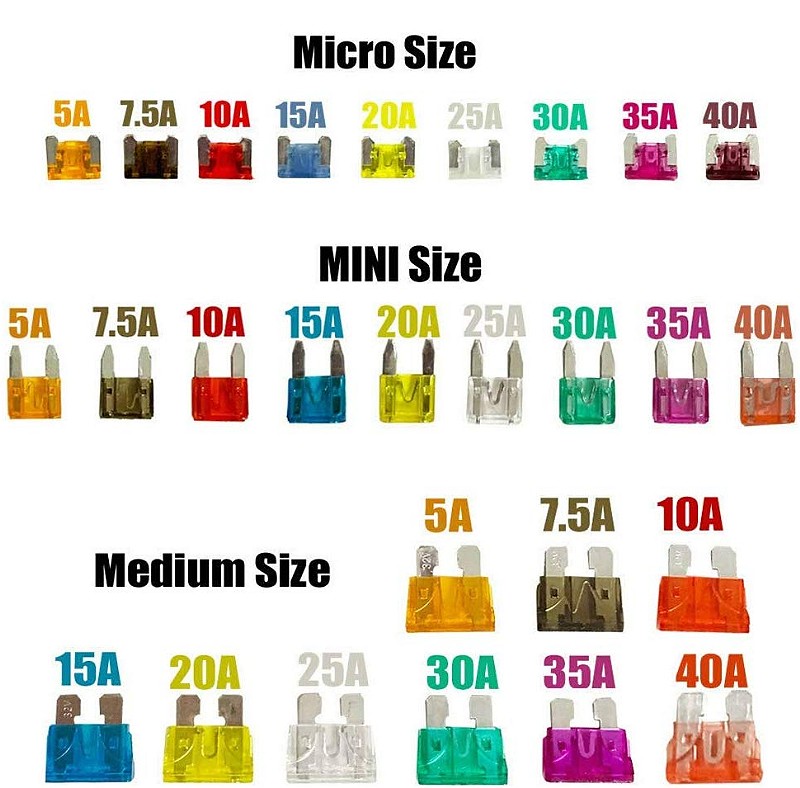 Close up of a blown fuse
Close up of a blown fuse -
Alternative Fuse Testing (Optional): For a more definitive test without removing the fuse, you can use a Bussmann fuse tester or similar fuse testing tool. These testers allow you to check fuse continuity while they are still in the fuse box. Simply align the tester prongs with the metal contact points on top of the fuse and observe the indicator light. A lit indicator usually means the fuse is good.
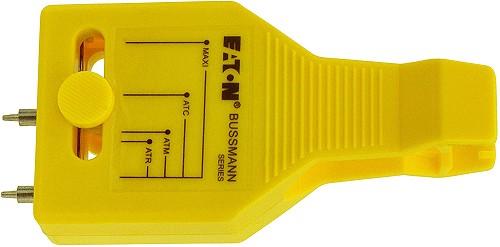 Bussmann Fuse Tester
Bussmann Fuse Tester -
Remove the Fuse: If you’ve determined a fuse is blown, use the fuse pulling tool (if available in your fuse panel) or needle-nose pliers to carefully remove the fuse from its slot.
-
Replace with the Correct Fuse: Crucially, always replace a blown fuse with a fuse of the exact same amperage rating. Using a fuse with a higher amperage rating can bypass the circuit protection, potentially causing serious wire damage or even a fire. Refer to the fuse diagrams and markings on the fuse panel for the correct amperage.
-
Install the New Fuse: Push the new fuse firmly into the empty slot until it’s fully seated.
-
Replace the Fuse Panel Cover: Reinstall the fuse panel cover securely.
Important Warning: Repeatedly blown fuses indicate an underlying electrical problem. While replacing a fuse can temporarily restore function, it’s essential to identify and repair the root cause of the overload. If fuses continue to blow after replacement, it’s recommended to have your 2002 Ford Ranger’s electrical system professionally inspected by a qualified mechanic.
Understanding Fuse Colors and Ratings
Fuses are color-coded to easily identify their amperage ratings. This color-coding system is standardized, making it simple to select the correct replacement fuse. Here’s a quick reference for common fuse colors and their corresponding amperage ratings:
- Red: 10 Amp
- Light Blue: 15 Amp
- Natural (Clear/White): 20 Amp
- Light Green: 30 Amp
 Close up of a blown fuse
Close up of a blown fuse
Always double-check the amperage rating printed on the fuse itself and match it with the replacement fuse, regardless of color, to ensure proper circuit protection for your 2002 Ford Ranger.
By understanding the 2002 Ford Ranger OBD2 fuse location and how to check and replace fuses, you can effectively troubleshoot common electrical issues and maintain the health of your vehicle’s systems. Remember to always prioritize safety and consult a professional if you encounter persistent electrical problems.